stripes
A carbonatite dyke which extends for about 1 km, but is never more than 30 cm wide, cuts gabbros of the Bushveld Complex and is composed of ankerite with interstitial calcite. A little chlorite, fine-grained quartz, apatite, sphalerite and pyrite are also present. Along the dyke small diatremes were identified by Strauss and Truter (1950b) the largest of which is about 50x10 m. They are filled with agglomerate, the blocks of which include a range of country rocks but are principally granite and a fine calcareous tuff including abundant crystal fragments. West of the northern end of the dyke is a one metre-wide and 300 m long dyke which is composite and composed of prehnite-aegirine rock and a rock type referred to by Strauss and Truter (1950b) as 'analcite picrite', but which consists, in order of abundance, of phlogopite, sodic pyroxene, calcite, analcime and magnetite with accessories including sodic amphibole and serpentine after olivine. The prehnite-aegirine rock contains patches of prehnite up to 5 mm across in a groundmass of prehnite, augite and aegirine, and a little phlogopite. Albitite forms a curving 320x30 m body and comprises essentially albite but with a little perthite, eudialyte and titanite. Analyses of all the rocks are given by Strauss and Truter (1950b).
STRAUSS, C.A. and TRUTER, F.C. 1950b. Post-Bushveld ultrabasic, alkali and carbonatitic eruptives at Magnet Heights, Sekukuniland, eastern Transvaal. Transactions of the Geological Society of South Africa, 53: 169-90VERWOERD, W.J. 1967. The carbonatites of South Africa and South West Africa. Geological Survey of South Africa, Handbook, 6: 1-452

